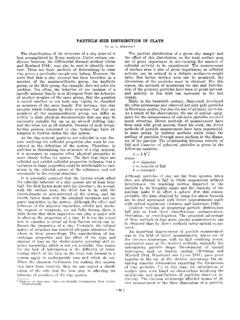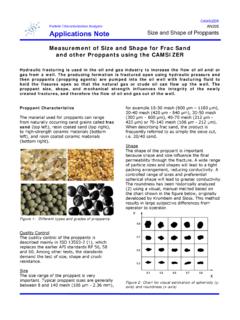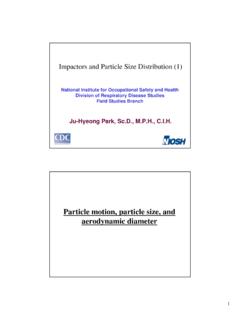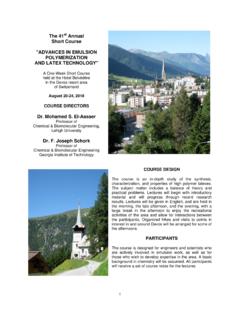Transcription of Characterization and Particle Size Control of Acrylic ...
1 Smithers Information Ltd, 201565 Polymers from Renewable Resources, Vol. 6, No. 2, 2015 Characterization and Particle size Control of Acrylic Polymer Latex Prepared with Green SurfactantsCharacterization and Particle size Control of Acrylic Polymer Latex Prepared with Green SurfactantsLijun Chen, Zhongbin Bao, Zhengrong Fu and Wen LiSchool of Chemical Engineering, Zhejiang University of Technology, Hangzhou 310032, ChinaReceived: 17 October 2014, Accepted: 25 November 2014 SummARyThe application of green surfactants, which have low toxicity, excellent biodegradability in emulsion polymerization, has not been reported in the literature.
2 In the present paper, alkyl polyglycosides (APG) and sodium alpha-olefin sulfonate (SAOS) were used as the nonionic emulsifier and anionic emulsifier, respectively to synthesize Acrylic polymer latex. The Acrylic polymer latex was prepared via semi-continuous seeded emulsion polymerization of butyl acrylate (BA) and methyl methacrylate (MMA) in water phase initiated with potassium persulfate (KPS) when nonylphenol ethoxylates (NPEOs) and sodium dodecyl-benzenesulfonate (SDBS) and are replaced with APG and SAOS, respectively. Both APG and SAOS have low toxicity, excellent biodegradability and outstanding properties.
3 The structure of the Acrylic polymer latex was confirmed with FTIR spectrum. Differential scanning calorimetry confirmed that the resultant latex is a kind of random copolymer. The unimodal distribution of Particle size also confirmed that the Acrylic polymer latex was prepared successfully. Factors, which have an influence on Particle size of the resultant latex, were studied in detail. The optimum recipe of preparing the Acrylic polymer latex with small Particle size was obtained. Keywords: Acrylic polymer latex; Semi-continuous seeded emulsion polymerization; Alkyl polyglycosides; Sodium alpha-olefin sulfonate INTRODuCTION Acrylic polymer latexes play an important role in many industrial processes, such as the production of synthetic rubber, surface coatings, adhesives, as additives in Corresponding author: Lijun Chen.
4 From Renewable Resources, Vol. 6, No. 2, 2015 Lijun Chen, Zhongbin Bao, Zhengrong Fu and Wen Lipaper, textiles and many other products. At present, emulsion polymerization of butyl acrylate (BA) and methyl methacrylate (MMA) is one of the most common methods for preparing Acrylic polymer latexes. Emulsion polymerization involves dispersion of a relatively water-insoluble monomer ( BA and MMA) in water at the reaction temperature, initiated the persulfate initiator solution with the aid of surfactants [1]. In the system of the emulsion polymerization, the anionic surfactant and non-ionic surfactant are often used as emulsifiers to stabilize the polymer latexes.
5 Usually, SDBS and NPEOs are widely used in industrial emulsion polymerization. Furthermore, SDBS and NPEOs residue in the environment [2]. However, there is a demand for biodegradable surfactants in the production of polymer latexes from a social and environmental viewpoint. In one of the major fields of application, surfactants with a more favorable ecological profile, which present low toxicity, excellent biodegradability, are becoming key ingredients for eco-friendly polymer latexes. Koukiotis et al. [3] synthesized high solids stable translucent nanolatexes of MMA/BA copolymers and MMA/BA/Veova-10 terpolymers by a modified semi-continuous microemulsion copolymerization.
6 In their work, a combination of various green industrial anionic and non-ionic surfactants free of alkylphenol ethoxylates (APEO-free) at low concentrations was used as emulsifiers. Huang et al. [4] prepared a polyacrylate emulsion by pre-emulsified semi-continuous seeded emulsion polymerization methods. In their study, environmental friendly alcohol ethoxylates(AEO-9), sulfosuccinic acid alkyl polyoxyethylene monoester disodium salt (A-102) and sorbitan monooleate (Span 80) instead of traditional APEO were chosen as surfactants in polymerization. Our research group also prepared polymer latexes emulsified with DSB and alkyl polyglycosides [5, 6].
7 However, the above studies are focused on the replacement of NPEOs. The study on the replacement of SDBS is neglected strongly. The aim of this study is that the application of green surfactants, which present low toxicity, excellent biodegradability in emulsion polymerization, has not been reported in open literatures. The novelty of the study is the Acrylic polymer latex is synthesized using alkyl polyglycosides (APG) and sodium alpha-olefin sulfonate (SAOS), as the nonionic emulsifier and anionic emulsifier, respectively. The synthetic route is given in Scheme 1.
8 The emphasis is put in the present work on optimizing the recipe of preparing the Acrylic polymer latex with small Particle size and its Characterization . Scheme 1. Synthetic route of preparing Acrylic polymer latex with green surfactants67 Polymers from Renewable Resources, Vol. 6, No. 2, 2015 Characterization and Particle size Control of Acrylic Polymer Latex Prepared with Green SurfactantsEXPERImENTALM aterialsBA and MMA were obtained from Shanghai Chemical Reagents Supply Procurement of Five Chemical Plants (China) and were distilled under reduced pressure prior to polymerization.
9 KPS was bought from the Second Chemical Reagent Factory in Yixin (China). The commercial APG such as C12/14-APG (APG1214) was purchased from Guangzhou Huiyuan Green Chemicals Limited (China). SAOS was a gift from Zhejiang Zanyu Technology Co. Ltd (China). Sodium bicarbonate (NaHCO3) was obtained from Shanghai Hongguang Chemicals (China). The water used in this experiment was distilled followed by of Acrylic Polymer Latex via Semi-continuous Seeded Emulsion PolymerizationThe Acrylic latex was prepared with semi-continuous seeded emulsion polymerization, which was carried out in a 250 ml four-neck flask equipped with reflux condenser, mechanical stirrer, dropping funnels and heated with the water bath.
10 The optimum recipe for preparing Acrylic polymer latex with small Particle size was shown in Table 1. First, NaHCO3, APG and SAOS were introduced into the reactor which contained g of de-ionized water and was heated with water bath at the constant temperature of 80 C under the condition of moderate agitation. Then 20% (wt%) KPS aqueous solution and 20% (wt%) the mixed monomers were dropped into the reactor within 15 min simultaneously, and the reaction maintained for another 15 min. At this time, the seeded latex was obtained. Then rest of mixed monomers and KPS aqueous solution was fed into the reactor containing seed latex under starved-feed addition through two dropping funnels simultaneously within h.







